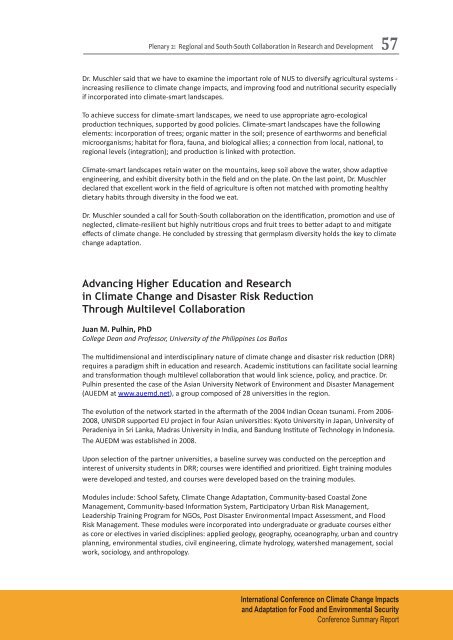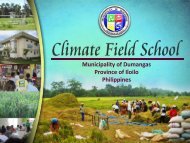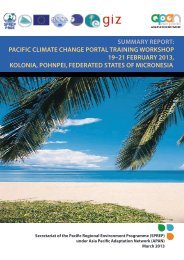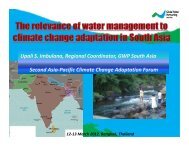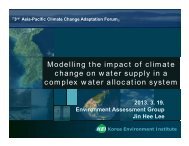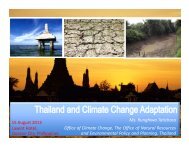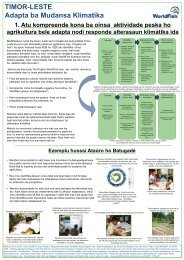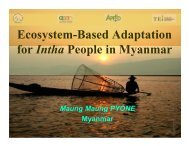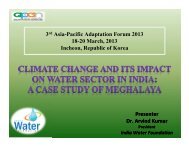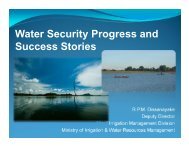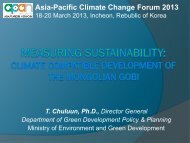PDF file (2.44 MB) - Asia Pacific Adaptation Network
PDF file (2.44 MB) - Asia Pacific Adaptation Network
PDF file (2.44 MB) - Asia Pacific Adaptation Network
You also want an ePaper? Increase the reach of your titles
YUMPU automatically turns print PDFs into web optimized ePapers that Google loves.
Plenary 2: Regional and South-South Collaboration in Research and Development57Dr. Muschler said that we have to examine the important role of NUS to diversify agricultural systems -increasing resilience to climate change impacts, and improving food and nutritional security especiallyif incorporated into climate-smart landscapes.To achieve success for climate-smart landscapes, we need to use appropriate agro-ecologicalproduction techniques, supported by good policies. Climate-smart landscapes have the followingelements: incorporation of trees; organic matter in the soil; presence of earthworms and beneficialmicroorganisms; habitat for flora, fauna, and biological allies; a connection from local, national, toregional levels (integration); and production is linked with protection.Climate-smart landscapes retain water on the mountains, keep soil above the water, show adaptiveengineering, and exhibit diversity both in the field and on the plate. On the last point, Dr. Muschlerdeclared that excellent work in the field of agriculture is often not matched with promoting healthydietary habits through diversity in the food we eat.Dr. Muschler sounded a call for South-South collaboration on the identification, promotion and use ofneglected, climate-resilient but highly nutritious crops and fruit trees to better adapt to and mitigateeffects of climate change. He concluded by stressing that germplasm diversity holds the key to climatechange adaptation.Advancing Higher Education and Researchin Climate Change and Disaster Risk ReductionThrough Multilevel CollaborationJuan M. Pulhin, PhDCollege Dean and Professor, University of the Philippines Los BañosThe multidimensional and interdisciplinary nature of climate change and disaster risk reduction (DRR)requires a paradigm shift in education and research. Academic institutions can facilitate social learningand transformation though multilevel collaboration that would link science, policy, and practice. Dr.Pulhin presented the case of the <strong>Asia</strong>n University <strong>Network</strong> of Environment and Disaster Management(AUEDM at www.auemd.net), a group composed of 28 universities in the region.The evolution of the network started in the aftermath of the 2004 Indian Ocean tsunami. From 2006-2008, UNISDR supported EU project in four <strong>Asia</strong>n universities: Kyoto University in Japan, University ofPeradeniya in Sri Lanka, Madras University in India, and Bandung Institute of Technology in Indonesia.The AUEDM was established in 2008.Upon selection of the partner universities, a baseline survey was conducted on the perception andinterest of university students in DRR; courses were identified and prioritized. Eight training moduleswere developed and tested, and courses were developed based on the training modules.Modules include: School Safety, Climate Change <strong>Adaptation</strong>, Community-based Coastal ZoneManagement, Community-based Information System, Participatory Urban Risk Management,Leadership Training Program for NGOs, Post Disaster Environmental Impact Assessment, and FloodRisk Management. These modules were incorporated into undergraduate or graduate courses eitheras core or electives in varied disciplines: applied geology, geography, oceanography, urban and countryplanning, environmental studies, civil engineering, climate hydrology, watershed management, socialwork, sociology, and anthropology.International Conference on Climate Change Impactsand <strong>Adaptation</strong> for Food and Environmental SecurityConference Summary Report


